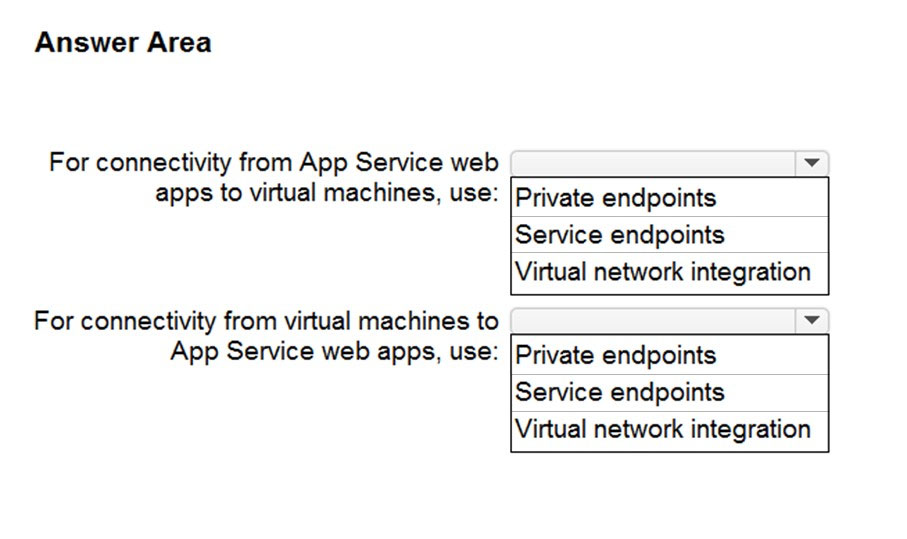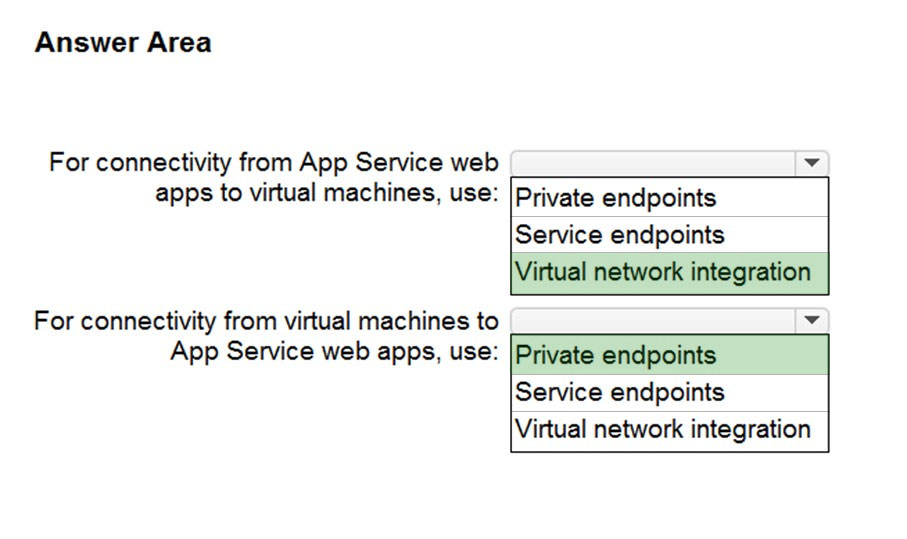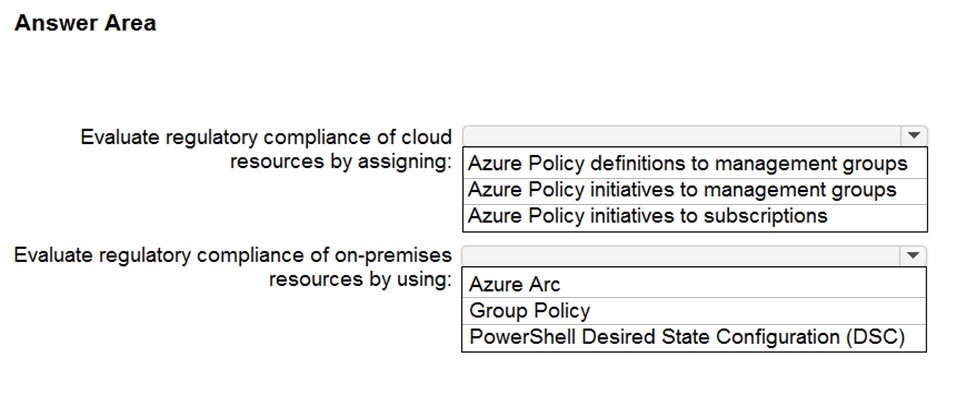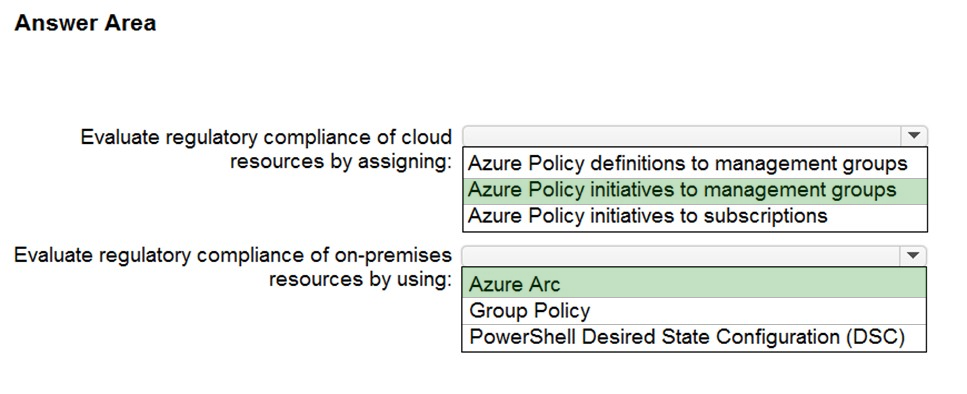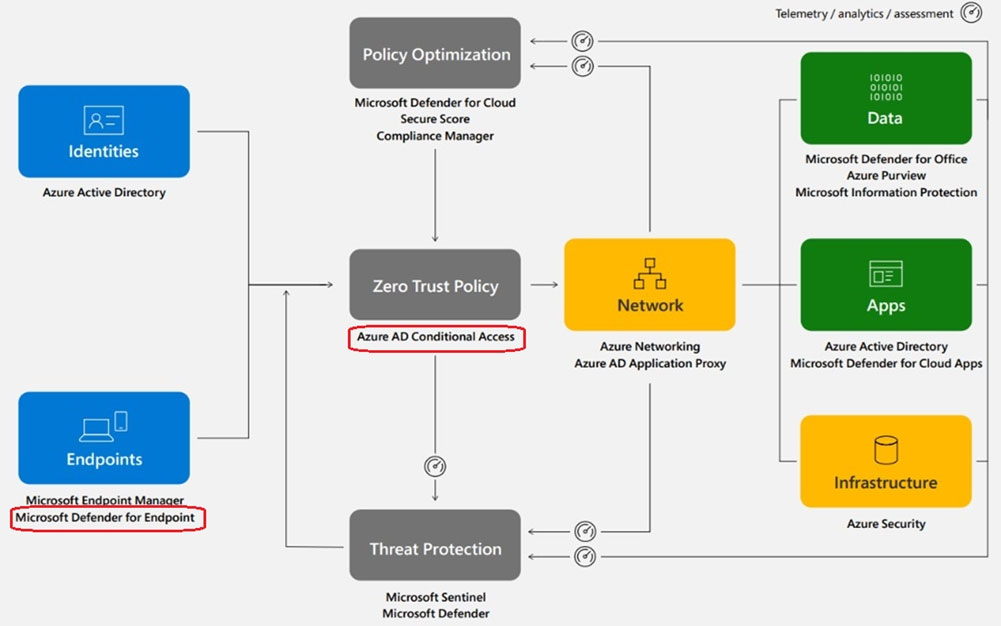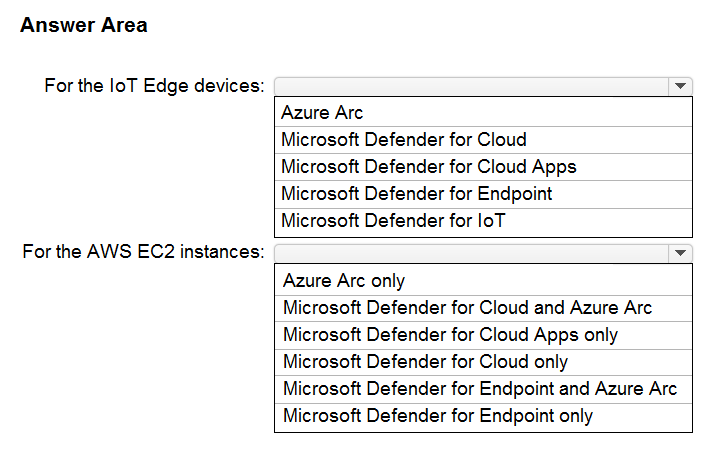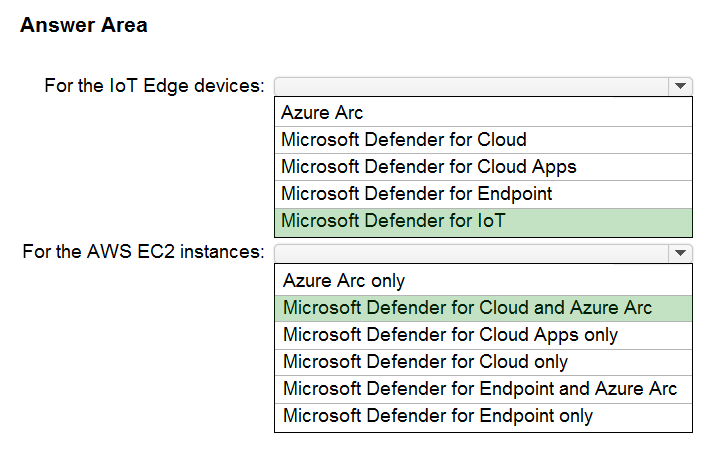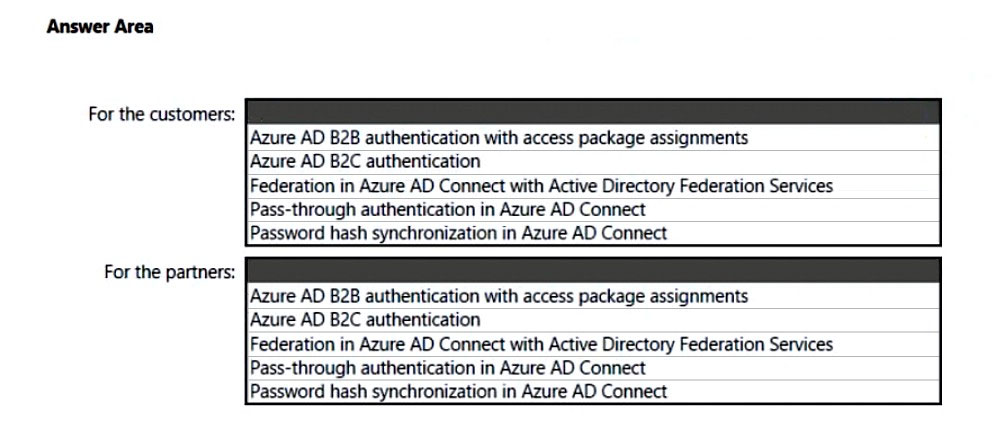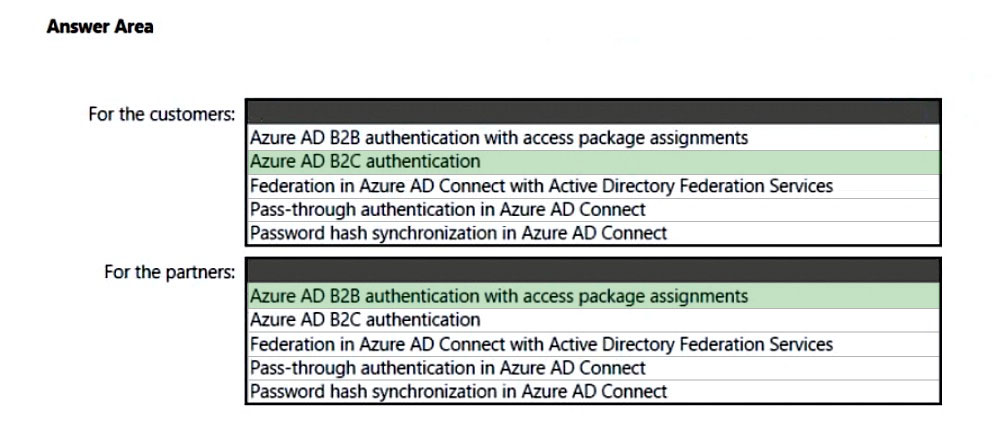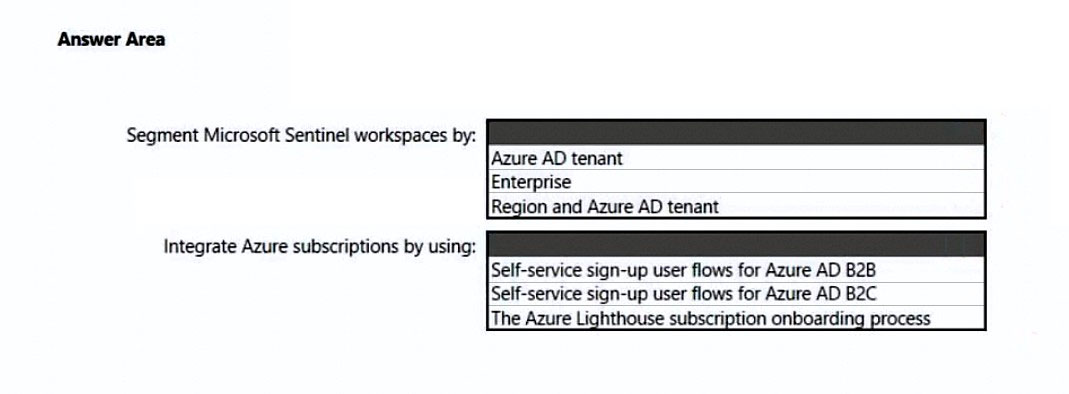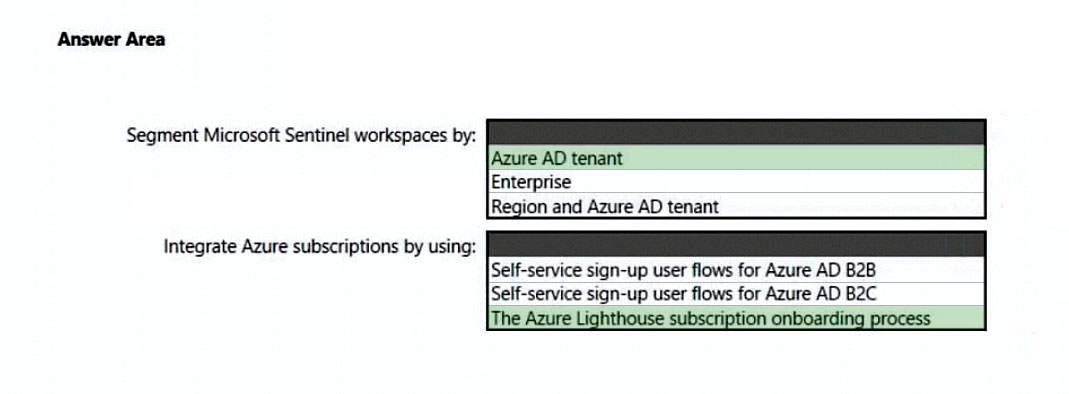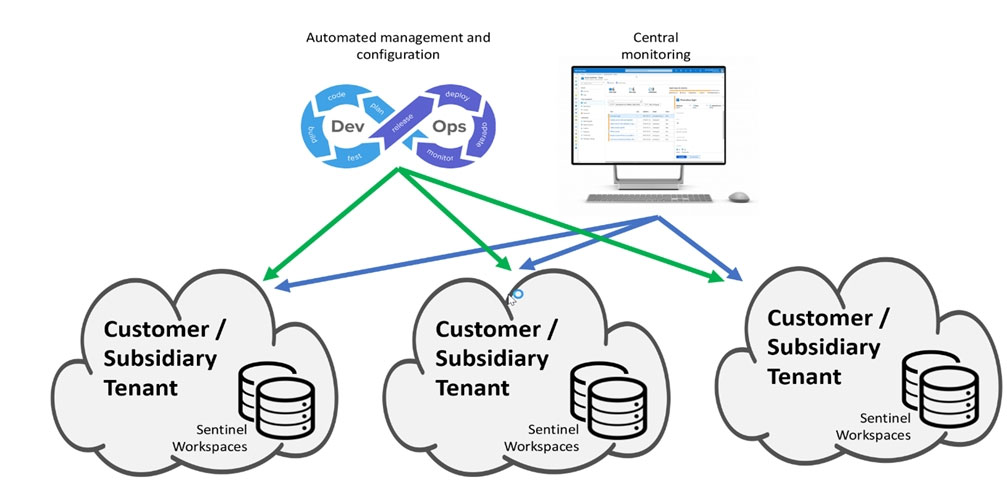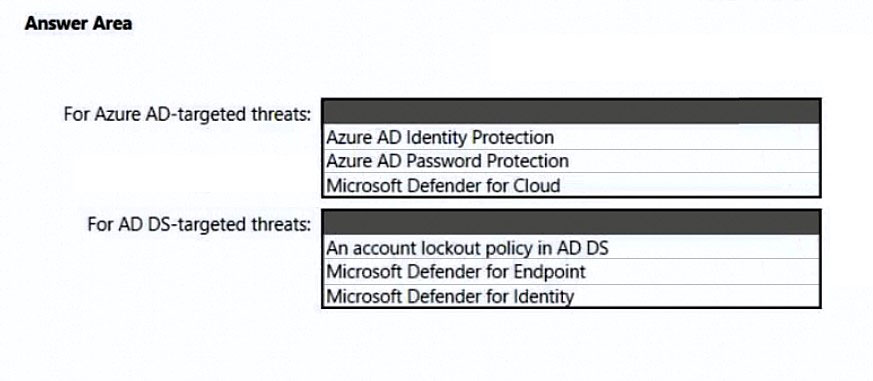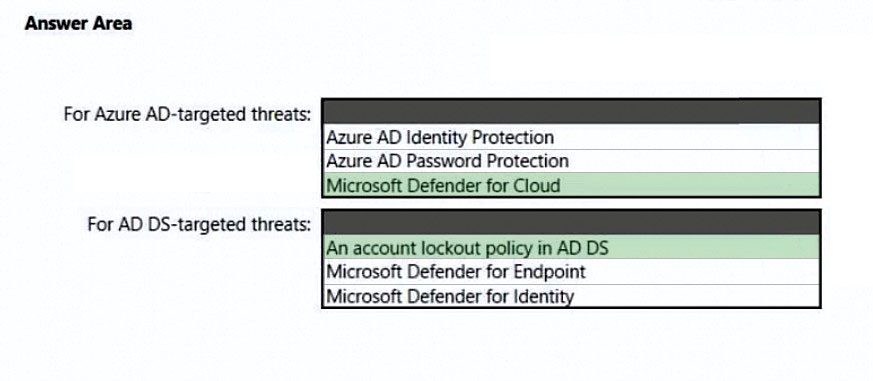SC-100 Practice Test Free – 50 Real Exam Questions to Boost Your Confidence
Preparing for the SC-100 exam? Start with our SC-100 Practice Test Free – a set of 50 high-quality, exam-style questions crafted to help you assess your knowledge and improve your chances of passing on the first try.
Taking a SC-100 practice test free is one of the smartest ways to:
- Get familiar with the real exam format and question types
- Evaluate your strengths and spot knowledge gaps
- Gain the confidence you need to succeed on exam day
Below, you will find 50 free SC-100 practice questions to help you prepare for the exam. These questions are designed to reflect the real exam structure and difficulty level. You can click on each Question to explore the details.
Your company has an Azure subscription that uses Azure Storage. The company plans to share specific blobs with vendors. You need to recommend a solution to provide the vendors with secure access to specific blobs without exposing the blobs publicly. The access must be time- limited. What should you include in the recommendation?
A. Configure private link connections.
B. Configure encryption by using customer-managed keys (CMKs).
C. Share the connection string of the access key.
D. Create shared access signatures (SAS).
You have a Microsoft 365 subscription and an Azure subscription. Microsoft 365 Defender and Microsoft Defender for Cloud are enabled. The Azure subscription contains 50 virtual machines. Each virtual machine runs different applications on Windows Server 2019. You need to recommend a solution to ensure that only authorized applications can run on the virtual machines. If an unauthorized application attempts to run or be installed, the application must be blocked automatically until an administrator authorizes the application. Which security control should you recommend?
A. OAuth app policies in Microsoft Defender for Cloud Apps
B. Azure Security Benchmark compliance controls in Defender for Cloud
C. application control policies in Microsoft Defender for Endpoint
D. app discovery anomaly detection policies in Microsoft Defender for Cloud Apps
You receive a security alert in Microsoft Defender for Cloud as shown in the exhibit. (Click the Exhibit tab.)After remediating the threat, which policy definition should you assign to prevent the threat from reoccurring?
A. Storage account public access should be disallowed
B. Azure Key Vault Managed HSM should have purge protection enabled
C. Storage accounts should prevent shared key access
D. Storage account keys should not be expired
After you answer a question in this section, you will NOT be able to return to it. As a result, these questions will not appear in the review screen. Your on-premises network contains an e-commerce web app that was developed in Angular and Node,js. The web app uses a MongoDB database. You plan to migrate the web app to Azure. The solution architecture team proposes the following architecture as an Azure landing zone.You need to provide recommendations to secure the connection between the web app and the database. The solution must follow the Zero Trust model. Solution: You recommend implementing Azure Key Vault to store credentials. Does this meet the goal?
A. Yes
B. No
You need to design a strategy for securing the SharePoint Online and Exchange Online data. The solution must meet the application security requirements. Which two services should you leverage in the strategy? Each correct answer presents part of the solution. NOTE: Each correct selection is worth one point.
A. Azure AD Conditional Access
B. access reviews in Azure AD
C. Microsoft Defender for Cloud
D. Microsoft Defender for Cloud Apps
E. Microsoft Defender for Endpoint
You have legacy operational technology (OT) devices and IoT devices. You need to recommend best practices for applying Zero Trust principles to the OT and IoT devices based on the Microsoft Cybersecurity Reference Architectures (MCRA). The solution must minimize the risk of disrupting business operations. Which two security methodologies should you include in the recommendation? Each correct answer presents part of the solution. NOTE: Each correct selection is worth one point.
A. active scanning
B. threat monitoring
C. software patching
D. passive traffic monitoring
HOTSPOT - You are planning the security levels for a security access strategy. You need to identify which job roles to configure at which security levels. The solution must meet security best practices of the Microsoft Cybersecurity Reference Architectures (MCRA). Which security level should you configure for each job role? To answer, select the appropriate options in the answer area. NOTE: Each correct selection is worth one point.
You have a Microsoft 365 subscription and an Azure subscription. Microsoft 365 Defender and Microsoft Defender for Cloud are enabled. The Azure subscription contains 50 virtual machines. Each virtual machine runs different applications on Windows Server 2019. You need to recommend a solution to ensure that only authorized applications can run on the virtual machines. If an unauthorized application attempts to run or be installed, the application must be blocked automatically until an administrator authorizes the application. Which security control should you recommend?
A. Azure AD Conditional Access App Control policies
B. Azure Security Benchmark compliance controls in Defender for Cloud
C. app protection policies in Microsoft Endpoint Manager
D. application control policies in Microsoft Defender for Endpoint
Your company has an Azure subscription that has enhanced security enabled for Microsoft Defender for Cloud. The company signs a contract with the United States government. You need to review the current subscription for NIST 800-53 compliance. What should you do first?
A. From Defender for Cloud, enable Defender for Cloud plans.
B. From Azure Policy, assign a built-in initiative that has a scope of the subscription.
C. From Defender for Cloud, review the secure score recommendations.
D. From Microsoft Defender for Cloud Apps, create an access policy for cloud applications.
A customer uses Azure to develop a mobile app that will be consumed by external users as shown in the following exhibit.You need to design an identity strategy for the app. The solution must meet the following requirements: ✑ Enable the usage of external IDs such as Google, Facebook, and Microsoft accounts. ✑ Use a customer identity store. ✑ Support fully customizable branding for the app. Which service should you recommend to complete the design?
A. Azure Active Directory (Azure AD) B2B
B. Azure Active Directory Domain Services (Azure AD DS)
C. Azure Active Directory (Azure AD) B2C
D. Azure AD Connect
HOTSPOT - You need to recommend a strategy for App Service web app connectivity. The solution must meet the landing zone requirements. What should you recommend? To answer, select the appropriate options in the answer area. NOTE: Each correct selection is worth one point. Hot Area:
You are designing a ransomware response plan that follows Microsoft Security Best Practices. You need to recommend a solution to limit the scope of damage of ransomware attacks without being locked out. What should you include in the recommendation?
A. device compliance policies
B. Privileged Access Workstations (PAWs)
C. Customer Lockbox for Microsoft Azure
D. emergency access accounts
HOTSPOT - You are designing a privileged access strategy for a company named Contoso, Ltd. and its partner company named Fabrikam, Inc. Contoso has an Azure AD tenant named contoso.com. Fabrikam has an Azure AD tenant named fabrikam.com. Users at Fabrikam must access the resources in contoso.com. You need to provide the Fabrikam users with access to the Contoso resources by using access packages. The solution must meet the following requirements: • Ensure that the Fabrikam users can use the Contoso access packages without explicitly creating guest accounts in contoso.com. • Allow non-administrative users in contoso.com to create the access packages. What should you use for each requirement? To answer, select the appropriate options in the answer area. NOTE: Each correct selection is worth one point.
You need to recommend a solution to scan the application code. The solution must meet the application development requirements. What should you include in the recommendation?
A. GitHub Advanced Security
B. Azure Key Vault
C. Azure DevTest Labs
D. Application Insights in Azure Monitor
After you answer a question in this section, you will NOT be able to return to it. As a result, these questions will not appear in the review screen. You are designing the encryption standards for data at rest for an Azure resource. You need to provide recommendations to ensure that the data at rest is encrypted by using AES-256 keys. The solution must support rotating the encryption keys monthly. Solution: For blob containers in Azure Storage, you recommend encryption that uses Microsoft-managed keys within an encryption scope. Does this meet the goal?
A. Yes
B. No
DRAG DROP - You have a Microsoft 365 subscription. You need to recommend a security solution to monitor the following activities: • User accounts that were potentially compromised • Users performing bulk file downloads from Microsoft SharePoint Online What should you include in the recommendation for each activity? To answer, drag the appropriate components to the correct activities. Each component may be used once, more than once, or not at all. You may need to drag the split bar between panes or scroll to view content. NOTE: Each correct selection is worth one point.
HOTSPOT - You are designing the security architecture for a cloud-only environment. You are reviewing the integration point between Microsoft 365 Defender and other Microsoft cloud services based on Microsoft Cybersecurity Reference Architectures (MCRA). You need to recommend which Microsoft cloud services integrate directly with Microsoft 365 Defender and meet the following requirements: • Enforce data loss prevention (DLP) policies that can be managed directly from the Microsoft 365 Defender portal. • Detect and respond to security threats based on User and Entity Behavior Analytics (UEBA) with unified alerting. What should you include in the recommendation for each requirement? To answer, select the appropriate options in the answer area. NOTE: Each correct selection is worth one point.
After you answer a question in this section, you will NOT be able to return to it. As a result, these questions will not appear in the review screen. You have an Azure subscription that has Microsoft Defender for Cloud enabled. You are evaluating the Azure Security Benchmark V3 report. In the Secure management ports controls, you discover that you have 0 out of a potential 8 points. You need to recommend configurations to increase the score of the Secure management ports controls. Solution: You recommend enabling just-in-time (JIT) VM access on all virtual machines. Does this meet the goal?
A. Yes
B. No
HOTSPOT - You need to recommend a solution to evaluate regulatory compliance across the entire managed environment. The solution must meet the regulatory compliance requirements and the business requirements. What should you recommend? To answer, select the appropriate options in the answer area. NOTE: Each correct selection is worth one point. Hot Area:
HOTSPOT - Your network contains an on-premises Active Directory Domain Services (AD DS) domain. The domain contains a server that runs Windows Server and hosts shared folders. The domain syncs with Azure AD by using Azure AD Connect. Azure AD Connect has group writeback enabled. You have a Microsoft 365 subscription that uses Microsoft SharePoint Online. You have multiple project teams. Each team has an AD DS group that syncs with Azure AD. Each group has permissions to a unique SharePoint Online site and a Windows Server shared folder for its project. Users routinely move between project teams. You need to recommend an Azure AD Identity Governance solution that meets the following requirements: • Project managers must verify that their project group contains only the current members of their project team. • The members of each project team must only have access to the resources of the project to which they are assigned. • Users must be removed from a project group automatically if the project manager has NOT verified the group's membership for 30 days. • Administrative effort must be minimized. What should you include in the recommendation? To answer, select the appropriate options in the answer area. NOTE: Each correct selection is worth one point.
HOTSPOT - You are evaluating the security of ClaimsApp. For each of the following statements, select Yes if the statement is true. Otherwise, select No. NOTE: Each correct selection is worth one point. Hot Area:
HOTSPOT - For a Microsoft cloud environment, you are designing a security architecture based on the Microsoft Cybersecurity Reference Architectures (MCRA). You need to protect against the following external threats of an attack chain: • An attacker attempts to exfiltrate data to external websites. • An attacker attempts lateral movement across domain-joined computers. What should you include in the recommendation for each threat? To answer, select the appropriate options in the answer area. NOTE: Each correct selection is worth one point.
You are planning the security requirements for Azure Cosmos DB Core (SQL) API accounts. You need to recommend a solution to audit all users that access the data in the Azure Cosmos DB accounts. Which two configurations should you include in the recommendation? Each correct answer presents part of the solution. NOTE: Each correct selection is worth one point.
A. Send the Azure Active Directory (Azure AD) sign-in logs to a Log Analytics workspace.
B. Enable Microsoft Defender for Identity.
C. Send the Azure Cosmos DB logs to a Log Analytics workspace.
D. Disable local authentication for Azure Cosmos DB.
E. Enable Microsoft Defender for Cosmos DB.
HOTSPOT - You have a Microsoft 365 E5 subscription that uses Microsoft Purview, SharePoint Online, and OneDrive for Business. You need to recommend a ransomware protection solution that meets the following requirements: • Mitigates attacks that make copies of files, encrypt the copies, and then delete the original files • Mitigates attacks that encrypt files in place • Minimizes administrative effort What should you include in the recommendation? To answer, select the appropriate options in the answer area. NOTE: Each correct selection is worth one point.
You design cloud-based software as a service (SaaS) solutions. You need to recommend a recovery solution for ransomware attacks. The solution must follow Microsoft Security Best Practices. What should you recommend doing first?
A. Develop a privileged identity strategy.
B. Implement data protection.
C. Develop a privileged access strategy.
D. Prepare a recovery plan.
After you answer a question in this section, you will NOT be able to return to it. As a result, these questions will not appear in the review screen. Your on-premises network contains an e-commerce web app that was developed in Angular and Node,js. The web app uses a MongoDB database. You plan to migrate the web app to Azure. The solution architecture team proposes the following architecture as an Azure landing zone.You need to provide recommendations to secure the connection between the web app and the database. The solution must follow the Zero Trust model. Solution: You recommend implementing Azure Front Door with Azure Web Application Firewall (WAF). Does this meet the goal?
A. Yes
B. No
A customer follows the Zero Trust model and explicitly verifies each attempt to access its corporate applications. The customer discovers that several endpoints are infected with malware. The customer suspends access attempts from the infected endpoints. The malware is removed from the endpoints. Which two conditions must be met before endpoint users can access the corporate applications again? Each correct answer presents part of the solution. NOTE: Each correct selection is worth one point.
A. The client access tokens are refreshed.
B. Microsoft Intune reports the endpoints as compliant.
C. A new Azure Active Directory (Azure AD) Conditional Access policy is enforced.
D. Microsoft Defender for Endpoint reports the endpoints as compliant.
You need to recommend a solution to secure the MedicalHistory data in the ClaimsDetail table. The solution must meet the Contoso developer requirements. What should you include in the recommendation?
A. row-level security (RLS)
B. Transparent Data Encryption (TDE)
C. Always Encrypted
D. data classification
E. dynamic data masking
After you answer a question in this section, you will NOT be able to return to it. As a result, these questions will not appear in the review screen. You are designing the encryption standards for data at rest for an Azure resource. You need to provide recommendations to ensure that the data at rest is encrypted by using AES-256 keys. The solution must support rotating the encryption keys monthly. Solution: For Azure SQL databases, you recommend Transparent Data Encryption (TDE) that uses customer-managed keys (CMKs). Does this meet the goal?
A. Yes
B. No
Your company has an Azure subscription that uses Microsoft Defender for Cloud. The company signs a contract with the United States government. You need to review the current subscription for NIST 800-53 compliance. What should you do first?
A. From Defender for Cloud, enable Defender for Cloud plans.
B. From Defender for Cloud, review the Azure security baseline for audit report.
C. From Defender for Cloud, add a regulatory compliance standard.
D. From Microsoft Defender for Cloud Apps, create an access policy for cloud applications.
You have a Microsoft 365 tenant. Your company uses a third-party software as a service (SaaS) app named App1 that is integrated with an Azure AD tenant. You need to design a security strategy to meet the following requirements: • Users must be able to request access to App1 by using a self-service request. • When users request access to App1, they must be prompted to provide additional information about their request. • Every three months, managers must verify that the users still require access to App1. What should you include in the design?
A. Microsoft Entra Identity Governance
B. connected apps in Microsoft Defender for Cloud Apps
C. access policies in Microsoft Defender for Cloud Apps
D. Azure AD Application Proxy
DRAG DROP - You have a hybrid Azure AD tenant that has pass-through authentication enabled. You are designing an identity security strategy. You need to minimize the impact of brute force password attacks and leaked credentials of hybrid identities. What should you include in the design? To answer, drag the appropriate features to the correct requirements. Each feature may be used once, more than once, or not at all. You may need to drag the split bar between panes or scroll to view content. NOTE: Each correct selection is worth one point.
You are designing the security standards for a new Azure environment. You need to design a privileged identity strategy based on the Zero Trust model. Which framework should you follow to create the design?
A. Microsoft Security Development Lifecycle (SDL)
B. Enhanced Security Admin Environment (ESAE)
C. Rapid Modernization Plan (RaMP)
D. Microsoft Operational Security Assurance (OSA)
After you answer a question in this section, you will NOT be able to return to it. As a result, these questions will not appear in the review screen. You are designing a security strategy for providing access to Azure App Service web apps through an Azure Front Door instance. You need to recommend a solution to ensure that the web apps only allow access through the Front Door instance. Solution: You recommend configuring gateway-required virtual network integration. Does this meet the goal?
A. Yes
B. No
HOTSPOT - Your company has a multi-cloud environment that contains a Microsoft 365 subscription, an Azure subscription, and Amazon Web Services (AWS) implementation. You need to recommend a security posture management solution for the following components: ✑ Azure IoT Edge devices AWS EC2 instances -Which services should you include in the recommendation? To answer, select the appropriate options in the answer area. NOTE: Each correct selection is worth one point. Hot Area:
HOTSPOT - Your company has a Microsoft 365 ES subscription, an Azure subscription, on-premises applications, and Active Directory Domain Services (AD DS). You need to recommend an identity security strategy that meets the following requirements: ✑ Ensures that customers can use their Facebook credentials to authenticate to an Azure App Service website ✑ Ensures that partner companies can access Microsoft SharePoint Online sites for the project to which they are assigned The solution must minimize the need to deploy additional infrastructure components. What should you include in the recommendation? To answer, select the appropriate options in the answer area. NOTE: Each correct selection is worth one point. Hot Area:
You have an Azure AD tenant that syncs with an Active Directory Domain Services (AD DS) domain. You are designing an Azure DevOps solution to deploy applications to an Azure subscription by using continuous integration and continuous deployment (CI/CD) pipelines. You need to recommend which types of identities to use for the deployment credentials of the service connection. The solution must follow DevSecOps best practices from the Microsoft Cloud Adoption Framework for Azure. What should you recommend?
A. a managed identity in Azure
B. an Azure AD user account that has role assignments in Azure AD Privileged Identity Management (PIM)
C. a group managed service account (gMSA)
D. an Azure AD user account that has a password stored in Azure Key Vault
HOTSPOT - You need to recommend a SIEM and SOAR strategy that meets the hybrid requirements, the Microsoft Sentinel requirements, and the regulatory compliance requirements. What should you recommend? To answer, select the appropriate options in the answer area. NOTE: Each correct selection is worth one point. Hot Area:
Your company is developing a new Azure App Service web app. You are providing design assistance to verify the security of the web app. You need to recommend a solution to test the web app for vulnerabilities such as insecure server configurations, cross-site scripting (XSS), and SQL injection. What should you include in the recommendation?
A. dynamic application security testing (DAST)
B. static application security testing (SAST)
C. interactive application security testing (IAST)
D. runtime application self-protection (RASP)
You have a Microsoft 365 subscription and an Azure subscription. Microsoft 365 Defender and Microsoft Defender for Cloud are enabled. The Azure subscription contains 50 virtual machines. Each virtual machine runs different applications on Windows Server 2019. You need to recommend a solution to ensure that only authorized applications can run on the virtual machines. If an unauthorized application attempts to run or be installed, the application must be blocked automatically until an administrator authorizes the application. Which security control should you recommend?
A. adaptive application controls in Defender for Cloud
B. app protection policies in Microsoft Endpoint Manager
C. app discovery anomaly detection policies in Microsoft Defender for Cloud Apps
D. Azure Security Benchmark compliance controls in Defender for Cloud
You need to recommend a strategy for routing internet-bound traffic from the landing zones. The solution must meet the landing zone requirements. What should you recommend as part of the landing zone deployment?
A. local network gateways
B. forced tunneling
C. service chaining
After you answer a question in this section, you will NOT be able to return to it. As a result, these questions will not appear in the review screen. You have an Azure subscription that has Microsoft Defender for Cloud enabled. You are evaluating the Azure Security Benchmark V3 report. In the Secure management ports controls, you discover that you have 0 out of a potential 8 points. You need to recommend configurations to increase the score of the Secure management ports controls. Solution: You recommend enabling the VMAccess extension on all virtual machines. Does this meet the goal?
A. Yes
B. No
You have a Microsoft 365 subscription and an Azure subscription. Microsoft 365 Defender and Microsoft Defender for Cloud are enabled. The Azure subscription contains 50 virtual machines. Each virtual machine runs different applications on Windows Server 2019. You need to recommend a solution to ensure that only authorized applications can run on the virtual machines. If an unauthorized application attempts to run or be installed, the application must be blocked automatically until an administrator authorizes the application. Which security control should you recommend?
A. app discovery anomaly detection policies in Microsoft Defender for Cloud Apps
B. Azure AD Conditional Access App Control policies
C. adaptive application controls in Defender for Cloud
D. app protection policies in Microsoft Endpoint Manager
DRAG DROP - You are designing a security operations strategy based on the Zero Trust framework. You need to increase the operational efficiency of the Microsoft Security Operations Center (SOC). Based on the Zero Trust framework, which three deployment objectives should you prioritize in sequence? To answer move the appropriate objectives from the list of objectives to the answer area and arrange them in the correct order.
You have a Microsoft 365 tenant. Your company uses a third-party software as a service (SaaS) app named App1. App1 supports authenticating users by using Azure AD credentials. You need to recommend a solution to enable users to authenticate to App1 by using their Azure AD credentials. What should you include in the recommendation?
A. Azure AD Application Proxy
B. Azure AD B2C
C. an Azure AD enterprise application
D. a relying party trust in Active Directory Federation Services (AD FS)
Your company is developing a serverless application in Azure that will have the architecture shown in the following exhibit.You need to recommend a solution to isolate the compute components on an Azure virtual network. What should you include in the recommendation?
A. Azure Active Directory (Azure AD) enterprise applications
B. an Azure App Service Environment (ASE)
C. Azure service endpoints
D. an Azure Active Directory (Azure AD) application proxy
You have an Azure subscription that has Microsoft Defender for Cloud enabled. You need to enforce ISO 27001:2013 standards for the subscription. The solution must ensure that noncompliant resources are remediated automatically. What should you use?
A. Azure Policy
B. Azure Blueprints
C. the regulatory compliance dashboard in Defender for Cloud
D. Azure role-based access control (Azure RBAC)
You have Microsoft Defender for Cloud assigned to Azure management groups. You have a Microsoft Sentinel deployment. During the triage of alerts, you require additional information about the security events, including suggestions for remediation. Which two components can you use to achieve the goal? Each correct answer presents a complete solution. NOTE: Each correct selection is worth one point.
A. Microsoft Sentinel threat intelligence workbooks
B. Microsoft Sentinel notebooks
C. threat intelligence reports in Defender for Cloud
D. workload protections in Defender for Cloud
Your company plans to deploy several Azure App Service web apps. The web apps will be deployed to the West Europe Azure region. The web apps will be accessed only by customers in Europe and the United States. You need to recommend a solution to prevent malicious bots from scanning the web apps for vulnerabilities. The solution must minimize the attack surface. What should you include in the recommendation?
A. Azure Firewall Premium
B. Azure Traffic Manager and application security groups
C. Azure Application Gateway Web Application Firewall (WAF)
D. network security groups (NSGs)
HOTSPOT - You need to recommend a strategy for securing the litware.com forest. The solution must meet the identity requirements. What should you include in the recommendation? To answer, select the appropriate options in the answer area. NOTE: Each correct selection is worth one point. Hot Area:
Free Access Full SC-100 Practice Test Free Questions
If you’re looking for more SC-100 practice test free questions, click here to access the full SC-100 practice test.
We regularly update this page with new practice questions, so be sure to check back frequently.
Good luck with your SC-100 certification journey!




